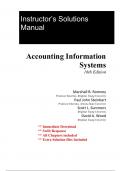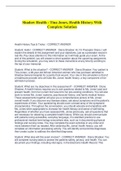Instructor’s Solutions
Manual
Accounting Information
Systems
16th Edition
Marshall B. Romney
Professor Emeritus, Brigham Young University
Paul John Steinbart
Professor Emeritus, Arizona State University
Scott L. Summers
Brigham Young University
David A. Wood
Brigham Young University
** Immediate Download
** Swift Response
** All Chapters included
** Extra Solution files Included
, CHAPTER 1
ACCOUNTING INFORMATION SYSTEMS: AN OVERVIEW
SUGGESTED ANSWERS TO DISCUSSION QUESTIONS
1.1 The value of information is the difference between the benefits realized from using that
information and the costs of producing it. Would you, or any organization, ever produce
information if its expected costs exceeded its benefits? If so, provide some examples. If not,
why?
Most organizations produce information only if its value exceeds its cost. However, there are two
situations where information may be produced even if its cost exceeds its value.
a. It is often difficult to estimate accurately the value of information and the cost of producing
it. Therefore, organizations may produce information that they expect will produce benefits
in excess of its costs, only to be disappointed after the fact.
b. Production of the information may be mandated by either a government agency or a private
organization. Examples include the tax reports required by the IRS and disclosure
requirements for financial reporting.
1.2 Can the characteristics of useful information listed in Table 1-1 be met simultaneously? Or
does achieving one mean sacrificing another?
Several of the criteria in Table 1.1 can be met simultaneously. For example, more timely
information is also likely to be more relevant. Verifiable information is likely to be more accurate.
However, achieving one objective may require sacrificing another. For example, ensuring that
information is more complete may reduce its timeliness. Similarly, increased verifiability and
accuracy may reduce its timeliness.
The decision maker must decide which trade-offs are warranted in each situation.
1.3 You and a few of your classmates decided to become entrepreneurs. You came up with a
great idea for a new mobile phone application that you think will make lots of money. Your
business plan won second place in a local competition, and you are using the $10,000 prize to
support yourselves as you start your company.
a. Identify the key decisions you need to make to be successful entrepreneurs, the
information you need to make them, and the business processes you will need to engage
in.
b. Your company will need to exchange information with various external parties. Identify
the external parties, and specify the information received from and sent to each of them.
The author turns this question into an in-class group activity. Students are divided up in groups,
told to close their books, and given 15 minutes to:
a. Think through the business processes, key decisions, and information needs issues in their
group.
, b. Identify the external users of information and specify the information received from and sent
to each of them.
One group is selected to present their answers to the class. The other groups are told to challenge
the group’s answers, provide alternative answers, and chip in with additional answers not provided
by the selected group. Since the group that presents is not selected until after the time has expired,
students are motivated to do a good job, as they will be presenting to their peers.
The value of this activity is not in arriving at a “right answer” as there are many right answers and
student answers will vary. Instead, it is in thinking through the issues presented in Table 1-2
(business processes, key decisions, and information needs) and Figure 1-1 (interactions with
external parties). Student answers should contain many of the things in Table 1-2 and Figure 1-1 as
well as others not shown, as a retail operation differs from an application development enterprise.
The author concludes the exercise by having the students turn to Table 1-2 and Figure 1-1 while he
emphasizes the need for owners, managers, and employees of organizations to identify the
information needed to make key decisions in the company’s business processes and the key
information interchanges with external parties. All the data needed to produce this information
must be entered into the AIS, processed, stored, protected, and made available to the appropriate
users.
While this active learning activity takes more time than a lecture does, it drives the point home
much better than a lecture would. It also keeps the students more engaged in the material.
1.4 How do an organization’s business processes and lines of business affect the design of its
AIS? Give several examples of how differences among organizations are reflected in their
AIS.
An organization’s AIS must reflect its business processes and its line of business. For example:
• Manufacturing companies will need a set of procedures and documents for the production
cycle; non-manufacturing companies do not.
• Government agencies need procedures to track separately all inflows and outflows from
various funds, to ensure that legal requirements about the use of specific funds are followed.
• Financial institutions do not need extensive inventory control systems.
• Passenger service companies (e.g., airlines, bus, and trains) generally receive payments in
advance of providing services. Therefore, extensive billing and accounts receivable
procedures are not needed; instead, they must develop procedures to account for prepaid
revenue.
• Construction firms typically receive payments at regular intervals, based on the percentage of
work completed. Thus, their revenue cycles must be designed to track carefully all work
performed and the amount of work remaining to be done.
• Service companies (e.g., public accounting and law firms) do not sell physical goods and,
therefore, do not need inventory control systems. They must develop and maintain detailed
records of the work performed for each customer to provide backup for the amounts billed.
Tracking individual employee time is especially important for these firms because labor is the
major cost component.
1.5 Figure 1-5 shows that organizational culture and the design of an AIS influence one another.
What does this imply about the degree to which an innovative system developed by one
company can be transferred to another company?






